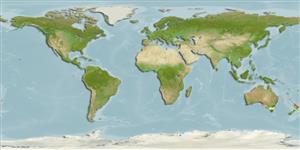Actinopterygii (Straalvinnigen) >
Perciformes (Perch-likes) >
Serranidae (Sea basses: groupers and fairy basslets) > Epinephelinae
Etymology: Epinephelus: Greek, epinephelos = cloudy (Ref. 45335).
Omgeving / Klimaat / Range
Ecologie
; marien rifbewoner; diepteverspreiding ? - 50 m (Ref. 5222). Subtropical, preferred ?; 25°S - 43°S, 136°E - 177°W (Ref. 5222)
Southwest Pacific: Australia, Lord Howe Island, Norfolk Island, Kermadec Islands and New Zealand (North Island and Poor Knights Island). The Australian range extends from southern Queensland to Kangaroo Island off South Australia; also reported from the Bass Strait.
Size / Gewicht / Leeftijd
Maturity: Lm ? range ? - ? cm
Max length : 200 cm TL mannelijk/geslacht niet bekend; (Ref. 9710); Maximaal gepubliceerd gewicht: 68.0 kg (Ref. 4787)
Dorsale stekels (totaal): 9; Dorsale zachte stralen (totaal): 14; Anale stekels 3; Anale zachte stralen: 8
Found on rocky substrata from near shore to at least 50 m. It is an aggressive territorial species that may occupy a particular cave for life. Small individuals feed on crabs and small fishes. Sexual transition reported to occur at 100-110 cm (Ref. 6787). Large individuals are often attracted by divers (Ref. 9710). An esteemed food fish avidly sought by anglers and spear fishermen.
Life cycle and mating behavior
Geslachtsrijpheid | Voortplanting | Kuitschieten | Eieren | Fecundity | Larven
Heemstra, P.C. and J.E. Randall, 1993. FAO Species Catalogue. Vol. 16. Groupers of the world (family Serranidae, subfamily Epinephelinae). An annotated and illustrated catalogue of the grouper, rockcod, hind, coral grouper and lyretail species known to date. Rome: FAO. FAO Fish. Synop. 125(16):382 p. (Ref. 5222)
Status op de Rode Lijst van het IUCN (Ref. 115185)
CITES (Ref. 94142)
Not Evaluated
Gevaarlijk voor mensen
Harmless
Gebruik door de mens
Visserij: visserij voor eigen gebruik; vis voor de hengelsport: ja
Meer informatie
Populaire namenSynoniemenMetabolismePredatorsEcotoxicologieVoortplantingGeslachtsrijpheidKuitschietenFecundityEierenOntwikkeling van de eieren
ReferentiesAquacultuurAquacultuurprofielKweeklijnenGeneticaAlleelfrequentiesErfelijkheidZiektenVerwerkingMass conversion
Tools
Speciale rapporten
Download XML
Internet-bronnen
